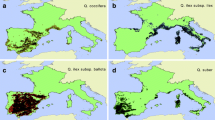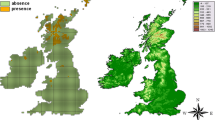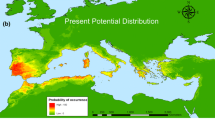Abstract
The genus Quercus is one of the most important tree species in Turkey. However, little is known on the ecological preferences of Turkish oak species regarding climate. We analyzed species response curves using a HOF-model approach to describe the general pattern of oak distributions along climatic gradients and to identify the driving climatic factors for eight oak species in Turkey. While climate data were extracted from the free available worldclim dataset, occurrence data on oak species were assembled from the literature into a vegetation database (n = 1,104). From the analyzed species response curves, only fa ew (16%) showed unimodal responses, while most were linear (31%) or exhibited a threshold response (31%). The driving factors were seasonality of temperature and seasonality of precipitation, indicating that Turkish oak species can be characterized best by the preference of climatic stability. These findings have important implications for conservation and climate change research, which usually focuses on trends of the mean values of temperature or precipitation but less often on the seasonality. In this study, we further tested whether niche optima derived from raw mean values of occurrences could replace missing model optima due to non-responsiveness of HOF models of type I. However, we did not find this to be a satisfactory solution. Finally, we discuss the need for the construction of a national database based on phytosociological relevés for Turkey.



Similar content being viewed by others
References
Adıgüzel N, Vural M (1995) Soğuksu Milli Parkı (Ankara) vejetasyonu. Turk J Bot 19:213–234
Akman Y, Barbero M, Quezel P (1978) Contribution a l’etude de la vegetation forestiere d’Anatolie mediterraneenne. Phytocoenologia 5:1–79
Akman Y, İlarslan R (1983) The Phytosociological investigation in the district of Uluhan-Mudurnu. Com de la Fac Sci Ank C5(1):55–70
Austin MP (1980) Searching for a model for use in vegetation analysis. Vegetatio 42:11–21
Austin MP (1987) Models for the analysis of species response to environmental gradients. Vegetatio 69:35–45
Austin MP (2002) Spatial prediction of species distribution: an interface between ecological theory and statistical modelling. Ecol Model 157:101–118
Austin MP, Smith TM (1989) A new model for the continuum concept. Vegetatio 83:35–47
Austin MP, Nicholls AO, Doherty MD, Meyers JA (1994) Determining species response functions to an environmental gradient by means of a β-Function. J Veg Sci 5:215–228
Babaç MT (2004) Possibility of an information system on plants of South-West Asia with particular reference to the Turkish Plants Data Service (TÜBIVES). Turk J Bot 28:119–227
Barbero M, Loisel R, Quézel P (1992) Biogeography, ecology and history of Mediterranean Quercus ilex ecosystems. Plant Ecol 99–100:19–34
Bartha D (1998) Quercus frainetto Ten. 1813. In: Schütt P, Schuck HJ, Aas G, Lang UM (eds) Enzyklopädie der Holzgewächse, 11edn. Wiley, Weinheim, pp 1–8
Borelli S, Varela MC (2000) EUFORGEN Mediterranean Oaks Network: Report of the first meeting. Antalya, Turkey
Bozzano M, Turok J. (2002) EUFORGEN Mediterranean Oaks Network: Second Meeting. 2–4 May 2002, Gozo, Malta
Burnham KP, Anderson DR (2002) Model selection and multimodel inference: a practical information-theoretic approach. Springer, Berlin
Camus A. (1934–1954) Les chenes: Monographie du genre Quercus (et Lithocarpus). Encyclopedie Economique de Sylviculture, Academie des Sciences, Paris.
Chytrý M, Danihelka J, Kubešová S, Lustyk P, Ermakov N, Hájek M, Hájková P, Kočí M, Otýpková Z, Roleček J, Řezníčková M, Šmarda P, Valachovič M, Popov D, Pišút I (2008) Diversity of forest vegetation across a strong gradient of climatic continentality: Western Sayan Mountains, southern Siberia. Plant Ecol 196:61–83
Çolak A, Rotherham I (2006) A review of the forest vegetation of Turkey: its Status Past and Present and its Future Conservation. Proc R Ir Acad B 106:343–354
Dengler J, Steering Committee GIVD (2010) GIVD, a new ecological metadatabase. Front Biogeogr 2:70
Dufour-Dror JM, Ertaş A (2004) Bioclimatic perspectives in the distribution of Quercus ithaburensis Decne. subspecies in Turkey and in the Levant. J Biogeogr 31:461–474
Flemons P, Guralnick R, Krieger J, Ranipeta A, Neufeld D (2007) A web-based GIS tool for exploring the world’s biodiversity: The global biodiversity information facility mapping and analysis portal application (GBIF-MAPA). Ecol Inform 2:49–60
Fotelli MN, Radoglou KM, Constantinidou HIA (2000) Water stress responses of seedlings of four Mediterranean oak species. Tree Physiol 20:1065–1075
Gauch HG, Whittaker RH (1972) Coenocline simulation. Ecology 53:446–451
Hennekens SM, Schaminée JHJ (2001) TURBOVEG, a comprehensive data base management system for vegetation data. J Veg Sci 12:589–591
Hijmans RJ, Cameron SE, Parra JL, Jones PG, Jarvis A (2005) Very high resolution interpolated climate surfaces for global land areas. Int J Climatol 25:1965–1978
Huisman J, Olff H, Fresco LFM (1993) A hierarchical set of models for species response analysis. J Veg Sci 4:37–46
Jansen F (2008a) Shape of species responses: Huisman-Olff-Fresco models revisited. In: Mucina L, Kalwij JM, Smith VR, Chytrý M, White PS, Cilliers SS, Pillar VD, Zobel M, Sun I-F (eds) Frontiers of Vegetation Science—An Evolutionary Angle. Keith Phillips Images, Somerset West, p 2
Jansen F. (2008b) vegdata.dev: Vegetation data access and evaluation. http://geobot.botanik.uni-greifswald.de/download, Accessed 15 March 2010.
Kalusová V, Le Duc MG, Gilbert JC, Lawson CS, Gowing DJ, Marrs RH (2009) Determining the important environmental variables controlling plant species community composition in mesotrophic grasslands in Great Britain. Appl Veg Sci 12:459–471
Kargioğlu M, Senkul C, Serteser A, Konuk M (2009) Bioclimatic requirements of Quercus vulcanica (Boiss Et Heldr. Ex) Kotschy—an endemic species in Turkey. Pol J Ecol 57:197–200
Kaya Z, Raynal DJ (2001) Biodiversity and conservation of Turkish forests. Biol Conserv 97:131–141
Ketenoğlu O, Tug GN, Bingol U, Geven F, Kurt L, Guney K (2010) Synopsis of syntaxonomy of Turkish forests. J Environ Biol 31:71–80
Kotschy T. (1858–1862) Die Eichen Europas und des Orients. Wien-Olmütz.
Lawesson JE, Oksanen J (2002) Niche characteristics of Danish woody species as derived from coenoclines. J Veg Sci 13:279–290
Manos PS, Doyle JJ, Nixon KC (1999) Phylogeny, biogeography, and processes of molecular differentiation in Quercus subgenus Quercus (Fagaceae). Mol Phylogenet Evol 12:333–349
Mayer H, Aksoy H (1986) Wälder der Türkei. Fischer, Stuttgart
Menitsky YL (1984) Oaks of Asia. Leningosed Sciences, St. Petersburg
Nakao K, Matsui T, Horikawa M, Tsuyama I, Tanaka N (2010) Assessing the impact of land use and climate change on the evergreen broad-leaved species of Quercus acuta in Japan. Plant Ecol. doi:10.1007/s11258-010-9817-7
Navarro T, Alados CL, Cabezudo B (2006) Changes in plant functional types in response to goat and sheep grazing in two semi-arid shrublands of SE Spain. J Arid Environ 64:298–322
Normand S, Treier UA, Randin C, Vittoz P, Guisan A, Svenning JC (2009) Importance of abiotic stress as a range-limit determinant for European plants: Insights from species responses to climatic gradients. Global Ecol Biogeogr 18:437–449
Oksanen J, Minchin PR (2002) Continuum theory revisited: what shape are species responses along ecological gradients? Ecol Model 157:119–129
Özel N. (2002) Country report: Turkey. In: Bozzano M. and Turok J. (eds), Mediterranean Oaks Network, Report of the second meeting, 2–4 May 2002. International Plant Genetic Resources Institute, Rome, Italy., Gozo, Malta, pp. 48–50.
Özen F (2010) Yeniköy (Bursa) Higrofil, Orman ve Maki Vejetasyonunun Sinekolojik ve Sintaksonomik Analizi. Ekoloji 19:50–64
Peppler-Lisbach C (2008) Using species-environmental amplitudes to predict pH values from vegetation. J Veg Sci 19:437–434
R Development Core Team (2010) R: A language and environment for statistical computing. R Foundation for Statistical Computing, Vienna, Austria
Rydgren K, Økland RH, Økland T (2003) Species response curves along environmental gradients. A case study from SE Norwegian swamp forests. J Veg Sci 14:869–880
Sariş F, Hannah DM, Eastwood WJ (2010) Spatial variability of precipitation regimes over Turkey. Hydrolog Sci J 55:234–249
Schaminée JHJ, Hennekens SM, Chytrý M, Rodwell JS (2009) Vegetation-plot data and databases in Europe: an overview. Preslia 81:173–185
Schwarz O (1936) Entwurf zu einem natürlichen system der cupuliferen und der Gattung Quercus L. Notizbl Bot Gart Mus Berlin-Dahlem 8:1–22
Schwarz O (1937) Monographie der Eichen Europas und der Mittelmeergebietes. Feddes Repertorium 1:1–200
Serteser A, Kargoğlu M, Senkul C, Konuk M (2009) An assessment on bioclimatic requirements of endemic Quercus aucheri Jaub. et Spach. communities spreading South-West Anatolia, Turkey. Asian J Plant Sci 8:35–41
Tayanç M, Im U, Dogruel M, Karaca M (2009) Climate change in Turkey for the last half century. Clim Change 94:483–502
Tsiourlis G, Konstantinidis P, Xofis P (2010) Syntaxonomy and synecology of Quercus coccifera Mediterranean shrublands in Greece. J Plant Biol 52:433–447
Uğurlu E, Senol SG (2005) Quercus—dominated vegetation units in the Aegean Region of Turkey. Bot Chron 18:283–291
Wamelink GWW, Goedhart PW, Van Dobben HF, Berendse F (2005) Plant species as predictors of soil pH: replacing expert judgement with measurements. J Veg Sci 16:461–470
Yaltirik F (1984) Türkiye Meşeleri Teşhis Kılavuzu. Tarim Orman ve Koyisleri Genel Mud. Yay, Istanbul
Zielioski J, Petrova A, Tomaszewski D (2006) Quercus trojana subsp. yaltirikii (Fagaceae), a new subspecies from southern Turkey. Willdenowia 36:845–849
Zohary M (1966) On the oak species of the Middle East. Bull Res Counc Isr Sect D 9:167–186
Acknowledgements
We thank Florian Jansen for adjusting his R-package for our needs, as well as Magda Pellowski and Sigrid Suchrow for their help with the HOF models. Furthermore, we thank Stephan Hennekens who helped us during the establishment phase of the database. We are grateful to Tracy Erwin for improving our English. Finally, we want to thank all participants from the 9th vegetation database conference and the organizing committee because at this conference the idea for this project was born, mainly due to the good atmosphere and many ideas.
Author information
Authors and Affiliations
Corresponding author
Electronic Supplementary Material
Below is the link to the electronic supplementary material.
Appendix 1
(DOC 115 kb)
Rights and permissions
About this article
Cite this article
Uğurlu, E., Oldeland, J. Species response curves of oak species along climatic gradients in Turkey. Int J Biometeorol 56, 85–93 (2012). https://doi.org/10.1007/s00484-010-0399-9
Received:
Revised:
Accepted:
Published:
Issue Date:
DOI: https://doi.org/10.1007/s00484-010-0399-9




